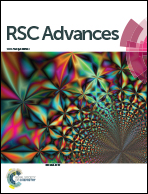Side-chain shuffling: regioselective synthesis of mixed tail discotic mesogens†
Abstract
A procedure for the regioselective synthesis of discotic mesogens bearing multiple side chains of different lengths is reported. A series of isomeric dibenzoquinoxaline mesogens obtained by this route showed phase behaviour that was highly sensitive to chain location.


 Please wait while we load your content...
Please wait while we load your content...